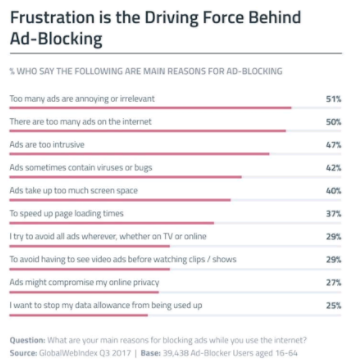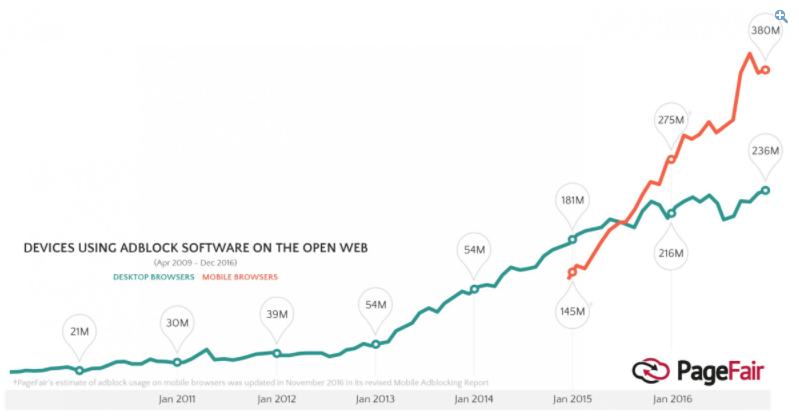Google launches a new version of its Chrome web browser today (February 15), which will include an in-built ad blocker to try and eradicate intrusive ads from the browsing experience.
There are some clear standards and some unanswered questions relating to this new approach, so what exactly do marketers need to know?
Google announced last year that certain ad types would be blocked automatically within Chrome. This seemingly seismic update is due to go live today in the latest upgrade to the world’s most popular web browser.
The integration of an ad blocker within Google Chrome is just a small part of a much bigger movement to improve the quality of online advertising, however.
This has been driven by consumers, who are increasingly frustrated with ads that interrupt and distract them from the content they want to view. As people spend more time on mobile devices and advertisers invest more in video, that tension has only heightened. 
The survey results in the image above tally with the findings from Google’s own research. Axios revealed recently that Google has found two concerning trends when analyzing user behavior on Chrome:
- One-in-five Chrome feedback reports mentions annoying/unwanted ads
- There were 5+ billion mutes from people using Google’s “mute this ad” feature in 2017
Of course, this has led to huge growth in the adoption of ad blockers over the last few years. Consumers have found these to be an easy and convenient solution, but this is not a permanent stance.
There is a widespread acceptance that if advertisers can provide some value to consumers, the latter will be much more receptive to the messaging.

Worryingly for advertisers and publishers, the growth in mobile ad blocker usage has been very notable and that trend has been particularly marked in the Asia-Pacific region over the past 12 months.
Many publishers have implemented “ad block walls”, which do not allow access to their content for users with an ad blocker installed. That approach is only a stop-gap measure and does not strike at the heart of the issue, however.
It is pretty clear which way the wind is blowing, so Google is aiming to take a modicum of control over the prevailing trend rather than ignore it altogether. Third-party ad blockers, after all, might also end up blocking ads from the Google Display Network.
Moreover, Chrome accounts for 62% of the mobile browser market and 59% of desktop, so it certainly has the clout to make a difference.
And yet, there is a fine balance to strike here between permitting the ads that fuel so much of the digital economy, while precluding those that are overly intrusive. Google, of course, has much to lose if it adopts an overzealous approach, but much to gain if it can become the arbiter of the correct standards for digital advertising.
Which ads will be affected?
The standards by which the Chrome ad blocker will operate are based on the guidelines set by the Coalition for Better Ads. Google is on the board that sets these regulations, but so are many other influential bodies, including the Association of National Advertisers, Unilever, and Facebook.
This collective set out to pinpoint the ad experiences that consumers found to be overly negative when browsing. The research (which can be viewed here) revealed certain types of ad that are most typically tied to negative experiences.
The desktop web experiences that will be affected are:

While the mobile ad types that will be affected are:

Of course, these are broad categories and there are levels of sophistication within each. Google has added the stipulation that publishers have a 7.5% non-compliance threshold before their ads are blocked.
There is also an element of common sense to be applied here. We have all been subjected to the kinds of ads that this initiative targets, whether they are full-screen auto-play videos or pop-up ads that feel impossible to close.
How will Google enforce this?
Significantly, Google estimates that just 1% of publishers will be affected in the short-term by the new ad blocker. It would be fair to say that the approach to cutting out sub-par ads has more in common with a scalpel than an axe. After all, Google knows better than anyone that advertising supports the vast majority of what we see online.
Wes MacLaggan, SVP of Marketing at Marin Software, commented to Search Engine Watch that:
These new standards are meant to create a better user experience for consumers, and ultimately encourage fewer ad blocking installations. In the short term, we’ll see some ad formats and advertisers shut off. These advertisers and publishers will need to invest in more quality ads, while publishers will no longer be able to rely on monetizing with intrusive formats.
Google will also alert sites that are at the “warning” or “failing” level on its scale, to provide an opportunity to clean up their ads. The search giant reports that 37% of sites that were initially in violation of their standards have since made changes to improve the quality of their ads.
Websites that violate the new standards will be given 30 days to remove the offending ads from their sites or Google will block their ads.

How will this affect advertisers and publishers?
It is a sign of how much the industry has changed that this is not quite the doomsday scenario it would have been for many just a few years ago.
The business model that drives so many publishers has been under threat for some time now. The move to a digital-first publishing world could only really be supported by a revenue model based on digital advertising, but unfortunately it has proved highly challenging to square this with the consumer’s best interests.
The ultimate aim for Google, via Chrome, is both ambitious and idealistic: to work with publishers and advertisers to create a customer-centric browsing experience. There are some clear statements on this from the Coalition for Better Ads, including the following:
The Coalition encourages advertisers, publishers, and advertising technology providers to review its research and the initial Better Ads Standards, as part of their efforts in the marketplace to improve the online ad experience.
- Advertisers can use the initial Better Ads Standards to inform campaign development and execution
- Publishers can use the initial Better Ads Standards to develop improved experiences for their audiences
- Ad technology platforms can use the initial Better Ads Standards in the development process for new ad experiences
- Providers of measurement technologies can use the initial Better Ads Standards to develop new ways to assess marketplace prevalence of the ad experiences preferred by consumers
Wes McLaggan of Marin Software has some further advice for advertisers as they take stock of how this update may affect them:
High quality, relevant ads are always going to perform better than those shouting to get a user’s attention. Marketers should leverage all targeting options to put the right ad in front of the right person. Ads should also reflect the user’s frame of mind when they are on that platform. There isn’t a one-size fits all approach for in-stream video on Facebook, Instagram Stories and display ads on a website. In short, digital advertisers should let user engagement, relevance, and ad quality be their guide.
Although an in-built ad blocker that initially affects 1% of publishers will not drive a fundamental shift in digital consumer-advertiser relationships on its own, it is undoubtedly a step in the right direction.




